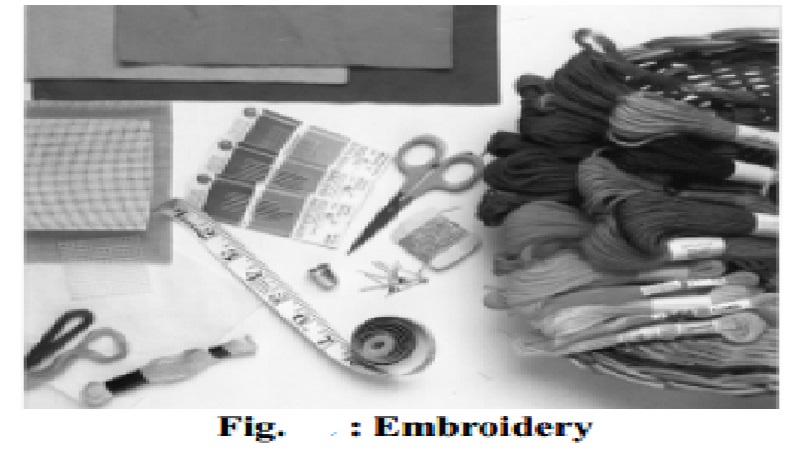Chapter: 11th 12th std standard Home Science Maintain Basic Knowledge for family life Higher secondary school College
Materials Required for Embroidery And Applique

Embroidery And Applique
Embroidery is one of the oldest of all crafts.
From earliest times, when all cloth was hand-woven-often from undyed
yarn-people have found various ways of embellishing it. The word 'embroidery'
conjures up a wealth of styles.
Materials Required
Fabrics
Embroidery can be worked on any pliable material from chiffon to
leather. The enormous range of both synthetic and natural fabrics can, in fact
be rather daunting to the beginner. Many synthetic fabrics have the advantage
of being cheaper and more durable than natural fabrics, but in general they are
more difficult to handle and are best avoided until you have gained some
experience with natural fabrics.
Threads
Embroidery
can be worked in many different kinds of thread-silk, cotton, linen, wool, synthetics
and metal in various weights and thicknesses. The distinctive qualities of
each-from the luster of silk to the soft, hairy texture of wool create
strikingly different effects. A piece of embroidery may be worked entirely in
one type of thread, or it may combine several different types to create
pleasing and exciting contrasts. The basic principle is that the thread and
fabric should be in sympathy with and complement one another.
Some of the most common embroidery threads are :
1.
Crewel and tapestry wool
2.
Cotton broader
3.
Pearl cotton
4.
Stranded cotton (embroidery floss)
5.
Soft embroidery cotton
6.
Silk floss
Twisted
button hole silk
Ordinary sewing or tacking (basting) thread may
be used in transfering a design.
Needles
The needle is such a simple tool, yet without it embroidery would be
impossible. The fine steel needles are used. There are a range of types, sizes
and gauges now available which have been developed for specific uses.
Sharp: Small round eye to take a single thread,
pointed tip. Used mainly for dressmaking.
Crewel : Long eye, slender, pointed tip.
Chenille: Long eye, shorter than crewel, larger
range of sizes, pointed tip.
Tapestry : Long eyes, blunt tip.
Beading : Very long, fine and flexible.
Darning : Similar to crewel.
Curved : Large and small-eyed, half circle
curve. Used mainly for upholstery.
When choosing a needle consider how it will be used. The thread or
threads should pass easily through the eye. The needle should make a hole in
the fabric large enough for the double thickness of thread, so that no effort
is required when pulling it through.
Tools
A pair of embroidery scissors with sharp,
pointed little blades is essential. These will cut thread neatly, making it
easy to insert in the needle.
For drawing and transferring designs onto the
fabric you will need a ruler and tape-measure, pencils and marking pen, french
chalk, graph paper, tracing paper and dress makers carbon.
Frames
The type of frame you choose will depend largely
on the size and type of embroidery, the fabric used, and whether or not you
want the work to be portable. Round frames are the simplest type of frame to
use, consisting only of two hoops placed one inside the other, trapping the
material between them. The outer hoop can be tightened by means of a screw at
the side. They are made of wood, comes in various sizes and some models can be
attached to a floor or table stand or clamp.
Finishing Technique
Soak the embroidered work in cold water, then lay it right side up,
while still wet, on a board covered with a clean cloth, such as an old sheet.
Nail it to the board, using drawing pins and beginning with the corners.
Continue nailing on all the four sides, alternately starting in the middle and
pulling the fabric taut. Allow the work to dry thoroughly.
Care of Embroidery
1.
Never hand embroidery in direct sunlight.
2.
Frequent washing and ironing should be avoided.
3.
Embroidered house-hold linen and furnishings can
be washed gently by hand in a mild liquid detergent and luke warm water if dyes
are fast. If dyes are not colour-fast then the embroidery must be dry cleaned.
4.
If embroidery must be stored for any length of
time it should always be cleaned first and packed in white acid-free tissue.
5.
Keep it in a dark, dry place and check it
frequently for moths.
Related Topics